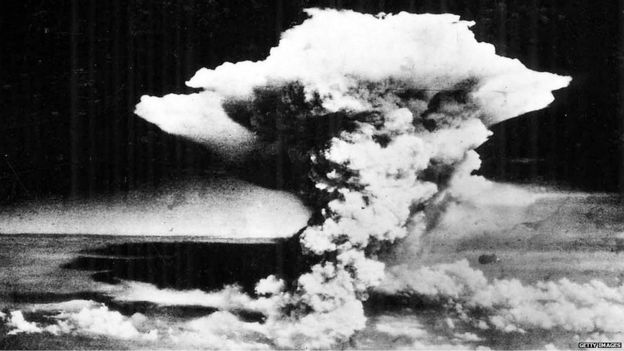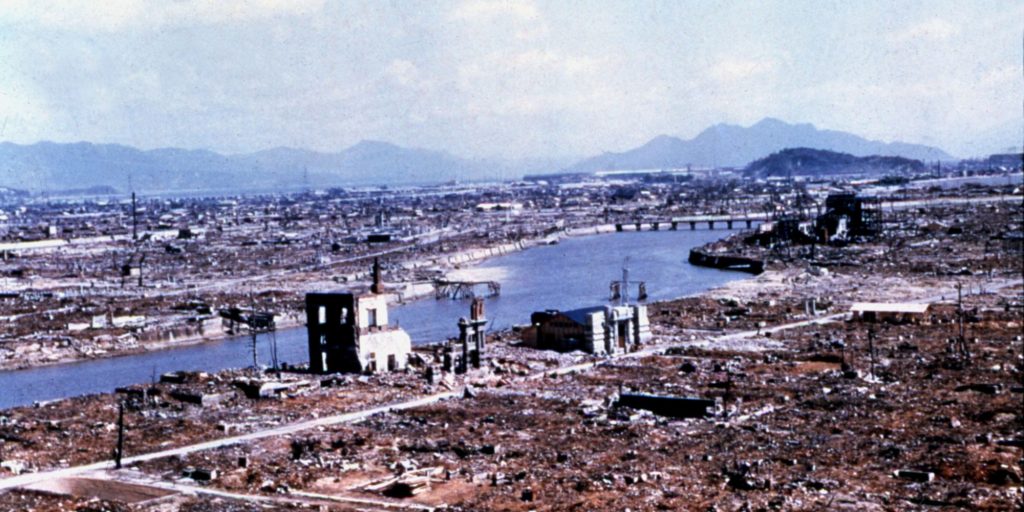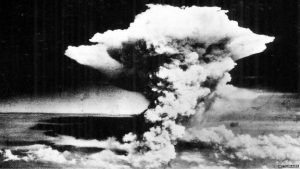
By Rich Pezzullo | The Save Jersey Blog
The misinformation about Hiroshima echoes Soviet Marshal Georgii Zhukov’s comments in 1971. He was present in Potsdam when Truman told Stalin about our “new bomb.”
The Soviet Spin -> “It was clear already then that the US Government intended to use the atomic weapon for the purpose of achieving its Imperialist goals from a position of strength in “the cold war.” This was amply corroborated on August 6 and 8. Without any military need whatsoever, the Americans dropped two atomic bombs on the peaceful and densely-populated Japanese cities of Hiroshima and Nagasaki.”
That is not true and needs to be rebutted whenever possible.
Truman used nuclear weapons to save lives. In his words, he “had hoped there was a possibility of preventing an Okinawa from one end of Japan to the other.”

The ‘crumbling” of the Japanese military in 1945 is largely a myth. Although their losses at Iwo Jima and Okinawa had been staggering, their navy had ceased to exist as an effective fighting force and the air corps had been decimated, their lack of air power diminished, but did not eliminate their ability to fight,. The Japanese continued to build up defenses at Kyushu, anticipated to be the Allied invasion point.
With lessons learned on Okinawa and Iwo Jima, the homeland would have a deadly active defense, with interlocking fields of fire of multiple munitions, deployed in depth from kamikaze attacking ships to artillery, mortars, long guns and small arms raking the beaches and finally mines and booby traps at every turn as our forces moved inland.
On the 3rd of April 1945, the Joint Chiefs formally directed Gen. Douglas MacArthur, then Commander in Chief of US Army Forces in the Pacific (CINCPAC), and Adm. Chester Nimitz, Commander in Chief of the Pacific Fleet and the Pacific Ocean Area (CINCPOA), to develop plans and begin preparations for an invasion of Kyushu. The directive had given 1 December as the invasion date for Kyushu and 1 March 1946 for Honshu.
The Japanese strategy was to survive an attempted invasion and seek a negotiated end to the conflict as both sides would be taking tremendous losses. Demonstrating that the United States possessed such destructive power changed the thinking of the Japanese leaders (military and civilian) and brought about the unconditional surrender for which America fought so hard.
The use of nuclear weapons stopped the war in days rather than months. It was not “overkill.” We could have delivered the same destructive force with a few thousand planes.
But the Japanese in occupied China were moving closer and closer to American airfields in China every day. They were killing 25,000 Chinese each week in the occupied territories – and their Kamikaze strategy was proving effective.
Intercepted communications reflected preparations for extensive use of suicide tactics. One series of messages indicated that up to 2,000 obsolete planes and trainers were being assigned to equip and train units for kamikaze missions. Instructions were issued to outfit biplanes and other older model aircraft with night operations equipment.
The US War Department’s Military Intelligence Service in mid-June increased its estimate of Japanese military manpower on Kyushu to 300,000. This estimate was disseminated just two days before President Truman was to meet with his senior military advisers to discuss planning for an invasion of Japan. The force developments it described were still consistent with the projections made a year earlier regarding Japanese forces likely to be defending Kyushu by the time of the planned invasion, now scheduled for 1 November 1945.
Truman was briefed on June 15 regarding casualty estimates when facing the anticipated EIGHT Japanese divisions. He was provided three scenarios, Southern Kyushu, followed by Tokyo Plain ( 193,000 killed or wounded) ,Southern Kyushu-Northwestern Kyushu (and Japan sur-renders withouT an attack on Tokyo) ( 132,000) – and the worst case, Southern Kyushu-Northwestern Kyushu-Tokyo Plain – forecasting 220,000 killed or wounded.
On 21 July, two weeks before unleashing the nuclear weapons, the Joint Chiefs raised the their strength report to TEN combat divisions as well as two depot divisions and there was an 11th division being moved there from Honshu. We ultimately learned that at the time of the Hiroshima bombing, the Japanese already had Thirteen Combat Divisions preparing to face an American invasion and another three months to harden their defenses.
Intercepted messages additional bases for piloted suicide torpedoes (kaiten) and preparations for using oil and gasoline incendiary devices, the deployment of a flotilla of 940 suicide aircraft to 18 concealed bases on Kyushu, as well as extensive efforts to reconfigure floatplanes for suicide missions. The same communications also showed training for night suicide attacks.
 The Japanese were testing methods to bomb the American mainland and they had improved their domestic defenses to the point that they withstood massive bombing raids on their homeland without capitulation.
The Japanese were testing methods to bomb the American mainland and they had improved their domestic defenses to the point that they withstood massive bombing raids on their homeland without capitulation.
Continued allied bombing would have killed hundreds of thousands or millions and have no effect on the enemy’s will or ability to resist invasion. To see the the long term effect of bombing – look at the ineffective results of Operation Rolling Thunder. From 2 March 1965 until 2 November 1968, it was the most intense air/ground battle waged during the Cold War period. And it failed to gain capitulation of the enemy. Or look to the bombing of England during WWII, which failed to get the British to surrender.
Only by demonstrating the ability to level cities as effectively as we had leveled Dresden, Berlin, Tokyo, Nagoya, Osaka, or Kobe – but without subjecting thousands of pilots to the risk of multiple missions – could we convince Japan that to continue the war of attrition was really placing their nation at the point of annihilation.
The bombs dropped August 6th and 9th. Later, the official U.S. Strategic Bombing Survey concluded that “certainly prior to December 31 1945 and in all probability prior to 1 November 1945, Japan would have surrendered even if the atomic bombs had not been dropped.”
Look carefully at that time line – “by December 31, 1945, Japan would have surrendered. ” From August 6 until November 1 the Japanese would be killing Chinese at a rate of 25,000 per week, they would be continuing to advance towards our bases in China, Kamikaze raids against our ships off Okinawa and Iwo Jima would continue and dozens of Japanese cities would be fire bombed with the brutal efficiency with which we destroyed Tokyo, Nagoya, Osaka and Kobe.
Additionally, D-Day for the mainland invasion had been moved from 1 December to 1 November, but with the buildup of forces the chiefs were looking to move it up even sooner. All that misery would have to be absorbed before the “ultimate surrender’ without nuclear weapons.
A pair of bombs – two flashes of light – and all that misery was prevented. The world was able to start healing.
Harry Truman’s use of nuclear weapons, in a manner intended to demonstrate that we could continue to do so at will and for a sustained period, ended the conflict, raging at it’s operational crescendo, in days instead of months.
That was not overkill. It was the final “knockout” punch in a war, started by a belligerent nation, which caused the deaths of millions of people and scarred families on three continents for generations.
________


